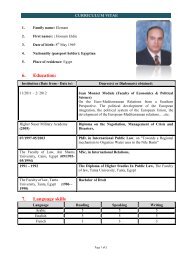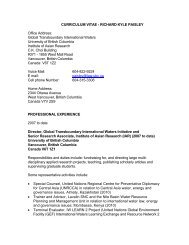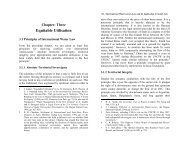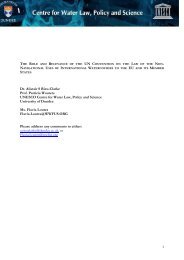Upreti, Trilochan, International Watercourses Law and Its Application ...
Upreti, Trilochan, International Watercourses Law and Its Application ...
Upreti, Trilochan, International Watercourses Law and Its Application ...
Create successful ePaper yourself
Turn your PDF publications into a flip-book with our unique Google optimized e-Paper software.
Introduction / 13 14 / <strong>International</strong> <strong>Watercourses</strong> <strong>Law</strong> <strong>and</strong> <strong>Its</strong> <strong>Application</strong> in South Asiastates in connection with the proposed project. 43 My workingexperience in this regard, particularly in the Nepalese context,is discussed below.1.5 Structure of the BookFollowing this introduction, Chapter Two deals with thedevelopment <strong>and</strong> codification of IWL. It evaluates statepractice, judicial pronouncements, <strong>and</strong> scholarly writings, inbilateral as well as in multilateral dimensions. Evolution ofthese principles, their far-reaching implications <strong>and</strong> criticalanalyses of these principles will be taken into consideration.Chapter Three deals with the concept of equity, itsdevelopment, the emerging concept of equitable utilisation inshared natural resources, <strong>and</strong> the jurisprudence of the<strong>International</strong> Court of Justice (ICJ) <strong>and</strong> its predecessor thePermanent Court of <strong>International</strong> Justice (PCIJ), in the area.The use of equitable utilisation in a shared natural resource hasbeen carried out to take account of the interests of all statesequally <strong>and</strong> without discrimination. It reconciles divergentneeds so as to ensure a fair deal. Apart from this, several courts,such as the ICJ, PCIJ <strong>and</strong> the decisions of numerous arbitrationtribunals <strong>and</strong> national courts in regard to the application ofequity <strong>and</strong> equitable sharing <strong>and</strong> utilisation, will be analysed.Chapter Four deals with IWL <strong>and</strong> its application in the Indo-Nepal context. In this chapter, Nepal’s past experience in waterprojects with her neighbour will be critically dealt with <strong>and</strong>43 D. Goldberg, "World Bank Policy on Projects on <strong>International</strong>Waterways in the context of the <strong>International</strong> <strong>Law</strong> Commission" in G.H. Blake, W. H. Hildsley, M. A. Pratt, R. J. Ridley &H. Schofield(eds), The Peaceful Management of Transboundary Resources,Dordrecht: Graham & Troatmat/Martinus Nijhoff, 1995, pp 153-165:Bank's Operational Directives (OD) 7.50, an internal policy documentrequired consent from a riparian states on the proposed project in aninternational watercourses in order to provide lending by the Bank.Other donors have adopted the same approach.how other states are doing in similar circumstances will beassessed. Moreover, how other states resolve the issues, howconflicts are averted <strong>and</strong> co-operation achieved, <strong>and</strong> how theyinfluence the Nepalese issues will be evaluated.Chapter Five critically described the legality of India's RiverLinking Project (RLP), its national <strong>and</strong> international dimension<strong>and</strong> its requirement to get rid from the recurring flood, drought<strong>and</strong> famine phenomenon in India <strong>and</strong> Bangladesh. Chapter Sixwill be a conclusion based on the evaluation, assessment <strong>and</strong>the critical analysis of the research. It also will presentconclusions drawn from all available materials, <strong>and</strong> suggest <strong>and</strong>identify the discrepancies, anomalies <strong>and</strong> shortcomings of thepresent system <strong>and</strong> recommend a better way out for theresolution of conflicts in a reasonable, sustainable <strong>and</strong> equitableway. Implications of the research for the areas of human rights,the environment <strong>and</strong> IWL will be provided. The main theme ofthe book will be the application of equity to resolve issuespertaining to the allocation <strong>and</strong> uses of these resources.However, the application of equity is itself a complicated task<strong>and</strong> there is no hard <strong>and</strong> fast rule on how it can apply to anyparticular watercourse. A critical analysis of its application <strong>and</strong>how states have resolved conflicts in similar situations to thatof India <strong>and</strong> Nepal <strong>and</strong> other neighbours will be made. Acritical analysis of four principles of international water lawwill be provided, e.g., territorial sovereignty, territorialintegrity, prior appropriation <strong>and</strong> equitable utilisation. I haveselected equitable utilisation as the best rule for its wideracceptance by the international community.To sum up this chapter, it can be stated that the earth, nature<strong>and</strong> the existence of living beings is impossible withoutfreshwater <strong>and</strong> the fact is that the availability of water isuneven, scarce <strong>and</strong> finite. The total availability of freshwater












